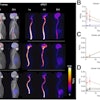The decision to add PET to an institution's menu of modalities should not be undertaken lightly. However, in a fiercely competitive imaging market, the technology can often be the factor that sets one group apart from another. Adding PET services -- either part-time with a mobile scanner or full-time with an installed unit -- requires a facility’s diagnostic radiologists to be competent and comfortable with the modality.
"When introducing a new modality, such as PET, into a practice or a hospital, I think there are three different phases of education that are critical," said Dr. Ethan Spiegler of Advanced Radiology in Baltimore. "One is the physician education piece. The second is the referring physician education piece, which is obviously just as crucial. The third one is really education for the staff at the center itself. Because without all of those different entities being able to understand what the modality is all about, it is unlikely that the hospital or the center providing the service will be successful."
Spiegler and one of his partners at Advanced Radiology, Dr. Lynn Harris, spoke with AuntMinnie.com about their firm’s PET education offerings. The PET program from Advanced Radiology is a practical, hands-on approach in real-time, where a physician-student is mentored by the group’s PET staff as it conducts day-to-day operations.
"To make a decision on the fly, in terms of that subtle finding there, how are you going to describe that to the referring physician? Aside from that, what are you going to recommend in terms of following up that finding? Is that something that needs to be biopsied? Is that something that needs just a serial CT scan in the future to make sure it’s stable because our probability of disease in that particular area is not so high? (The program) forces the physician that is interpreting the study to show that level of certainty or uncertainty to the student in how it’s dealt with," Spiegler said.
The three-day course enables three or four visiting physician-students to actively participate in PET cases as they are performed at the facility. There are five members of the Advanced Radiology staff, four radiology-trained and one trained in internal medicine, who partner with the students on a rotating one-on-one basis.
"I think the one-on-one interaction that students have with us is much more conducive for learning than sitting in a big conference room with 150 people. You get to ask questions, for example: ‘How would you read this, what would you say about that?’ So it makes it much more comfortable, I think, for the person who is there learning," Harris said.
This type of education is best done in a live setting involving actual patients, Spiegler said.
"We provide a background on the modality itself, in terms of how it’s performed, how patients actually come in and get injected with the radiopharmaceutical, how they are actually scanned on the scanner, how the data is manipulated, and how it’s ultimately viewed and archived. These are important for the interpreting physician to understand," he said.
The group offers hands-on training with live cases in both a freestanding PET facility and with a mobile PET system. There is also an online teaching file of nearly 200 cases available to the students. The live cases, generally 10 to 15 per day, cover most of the oncology indications that the Centers for Medicare and Medicaid Services (CMS) has approved for reimbursement with the modality.
"Obviously, the majority of our cases are going to be whatever the statistics are as far as the more likely cancers, so that’s what students are going to see. They are going to see the solitary pulmonary nodules (SPNs), the lymphomas, the melanomas, and breast cancer most commonly. We also have a teaching file already set up; that is included in part of the day or part of the conference that we go through with the students when they are there," Harris said.
Between the teaching files and the live cases, physicians should have roughly 200 PET cases under their belt by the time they leave the course, Spiegler said. In addition, the group provides its visiting physician-students with two weeks of free overreads on their PET cases once they have completed the course.
"What becomes, I think, more challenging, both for the educator and also for the student, is when the case is put up in front of you as the patient comes off the scanner and you see something subtle," he said. "The issue is, how does the radiologist in the live setting describe those findings and interpret those findings to answer the referring physician’s question? I think that the interaction of the visiting physician, the student ... and the (educator) is certainly enhanced on both sides by looking at these live cases that come through the center."
By Jonathan S. BatchelorAuntMinnie.com staff writer
November 29, 2002
Related Reading
CMS to maintain PET payment rates, November 8, 2002
Wagner sees bright future for molecular imaging, October 31, 2002
PET center deploys "secret weapon" in marketing efforts, October 24, 2002
RFP can define scope, chart success of mobile PET, August 2, 2002
Successful PET centers require planning and persistence, July 15, 2002
Copyright © 2002 AuntMinnie.com




















